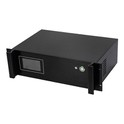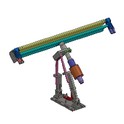Temperature is a crucial factor that can significantly influence various industrial processes, and the ultrasonic filtration process is no exception. As a leading supplier of ultrasonic filtration systems, we have witnessed firsthand how temperature variations can impact the efficiency, performance, and overall effectiveness of these systems. In this blog post, we will delve into the intricate relationship between temperature and the ultrasonic filtration process, exploring the underlying mechanisms, potential challenges, and strategies to optimize system performance under different temperature conditions.
Understanding the Ultrasonic Filtration Process
Before we discuss the impact of temperature, let's briefly review the basic principles of ultrasonic filtration. Ultrasonic filtration combines the power of ultrasonic waves with traditional filtration techniques to enhance the separation of particles from a fluid medium. The ultrasonic waves generate high-frequency vibrations that create cavitation bubbles in the fluid. These bubbles collapse rapidly, producing intense local pressure and shear forces that can dislodge and break up particles, preventing them from clogging the filter media. This process not only improves the filtration efficiency but also extends the lifespan of the filter elements.


The Influence of Temperature on Cavitation
One of the primary ways temperature affects the ultrasonic filtration process is through its impact on cavitation. Cavitation is highly sensitive to temperature, as it depends on the physical properties of the fluid, such as vapor pressure and surface tension. As the temperature increases, the vapor pressure of the fluid rises, making it easier for cavitation bubbles to form. However, at the same time, the surface tension of the fluid decreases, which can cause the bubbles to collapse more quickly and with less intensity.
In general, there is an optimal temperature range for cavitation to occur most effectively. At lower temperatures, the vapor pressure is too low, and it becomes difficult to initiate cavitation. On the other hand, at very high temperatures, the bubbles may collapse prematurely, reducing the overall cavitation effect. For most ultrasonic filtration applications, the optimal temperature range is typically between 20°C and 40°C. Outside this range, the efficiency of the filtration process may be compromised.
Effects on Particle Separation
Temperature can also have a direct impact on the separation of particles during the ultrasonic filtration process. As the temperature changes, the physical properties of the particles and the fluid medium can be altered, affecting their interaction with the filter media and the ultrasonic waves.
For example, at higher temperatures, the viscosity of the fluid decreases, which can lead to faster flow rates through the filter. While this may seem beneficial in terms of increasing the throughput, it can also reduce the contact time between the particles and the ultrasonic waves, potentially decreasing the effectiveness of particle dislodgment and breakage. Additionally, some particles may become more soluble or prone to agglomeration at higher temperatures, which can further complicate the filtration process.
Conversely, at lower temperatures, the viscosity of the fluid increases, which can slow down the flow rate and increase the pressure drop across the filter. This can lead to a higher risk of filter clogging and reduced filtration efficiency. Moreover, the reduced mobility of the particles at lower temperatures may make it more difficult for the ultrasonic waves to dislodge them from the filter media.
Impact on Filter Media
The temperature can also affect the performance and lifespan of the filter media used in ultrasonic filtration systems. Different filter materials have different temperature limits, and exposure to temperatures outside these limits can cause the media to degrade, lose its structural integrity, or change its filtration properties.
For instance, some polymer-based filter media may become brittle at low temperatures, increasing the risk of cracking and leakage. At high temperatures, the media may soften or melt, leading to a loss of filtration efficiency and potential contamination of the filtrate. Additionally, temperature fluctuations can cause thermal expansion and contraction of the filter media, which can lead to mechanical stress and premature failure.
Strategies to Mitigate Temperature Effects
To ensure optimal performance of ultrasonic filtration systems under varying temperature conditions, several strategies can be employed:
- Temperature Control: Implementing a temperature control system is essential to maintain the fluid within the optimal temperature range for cavitation and filtration. This can involve using heaters or coolers to adjust the temperature as needed. For example, in applications where the process fluid is initially at a low temperature, a heater can be used to raise the temperature to the optimal level. Conversely, in high-temperature processes, a cooler can be employed to lower the temperature.
- Selection of Filter Media: Choosing the right filter media is crucial, especially when dealing with extreme temperature conditions. Select filter materials that are resistant to thermal degradation and have a wide operating temperature range. For example, ceramic filter media are known for their high-temperature resistance and can be a suitable choice for applications involving hot fluids.
- Adjustment of Ultrasonic Parameters: The ultrasonic parameters, such as frequency, power, and duty cycle, can be adjusted based on the temperature of the fluid. At higher temperatures, reducing the ultrasonic power may be necessary to prevent excessive cavitation and potential damage to the filter media. Conversely, at lower temperatures, increasing the power or adjusting the frequency may enhance the cavitation effect and improve the filtration efficiency.
Our Ultrasonic Filtration Systems
As a supplier of ultrasonic filtration systems, we offer a wide range of products designed to meet the diverse needs of our customers. Our Ultrasonic Pipe Filter is ideal for inline filtration applications, where it can be easily integrated into existing pipelines. It provides efficient particle separation and can be customized to suit different flow rates and temperature requirements.
Our Ultrasonic Tank Filter is suitable for batch filtration processes in tanks or vessels. It offers a high degree of flexibility and can be used in various industries, including chemical, pharmaceutical, and food processing. Both our pipe and tank filters are equipped with advanced ultrasonic technology and can be optimized for different temperature conditions to ensure maximum performance.
Conclusion
Temperature plays a critical role in the ultrasonic filtration process, affecting cavitation, particle separation, and filter media performance. By understanding the relationship between temperature and the filtration process, and implementing appropriate strategies to mitigate temperature effects, it is possible to optimize the performance and efficiency of ultrasonic filtration systems.
If you are interested in learning more about our ultrasonic filtration systems or have specific requirements regarding temperature control and filtration performance, we encourage you to contact us. Our team of experts is ready to assist you in selecting the right system for your application and providing you with the support you need to achieve the best results.
References
- Thompson, D. O., & Doraiswamy, L. K. (1999). Ultrasonics in chemical processing. Industrial & Engineering Chemistry Research, 38(12), 4910-4948.
- Mason, T. J., & Lorimer, J. P. (2002). Applied sonochemistry: Uses of power ultrasound in chemistry and processing. Wiley.
- Povey, M. J. W. (1997). Ultrasonic techniques for fluid characterization. Academic Press.





